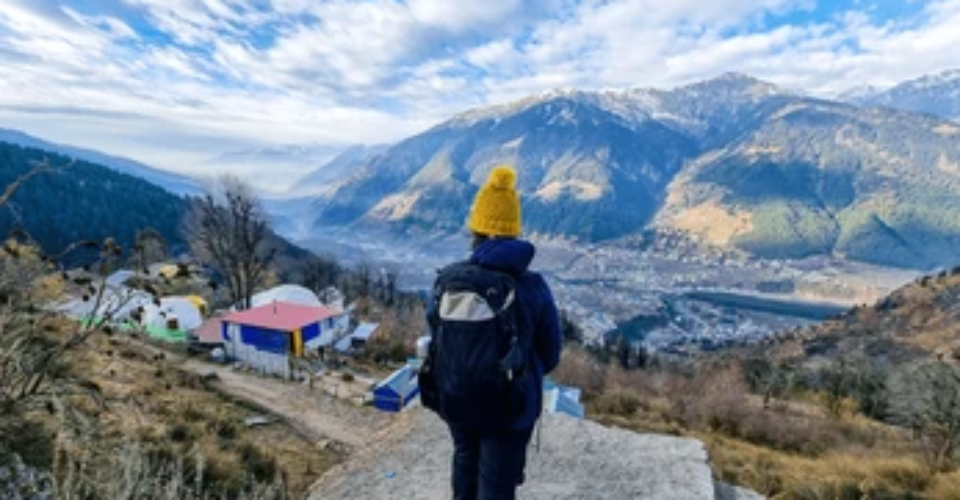
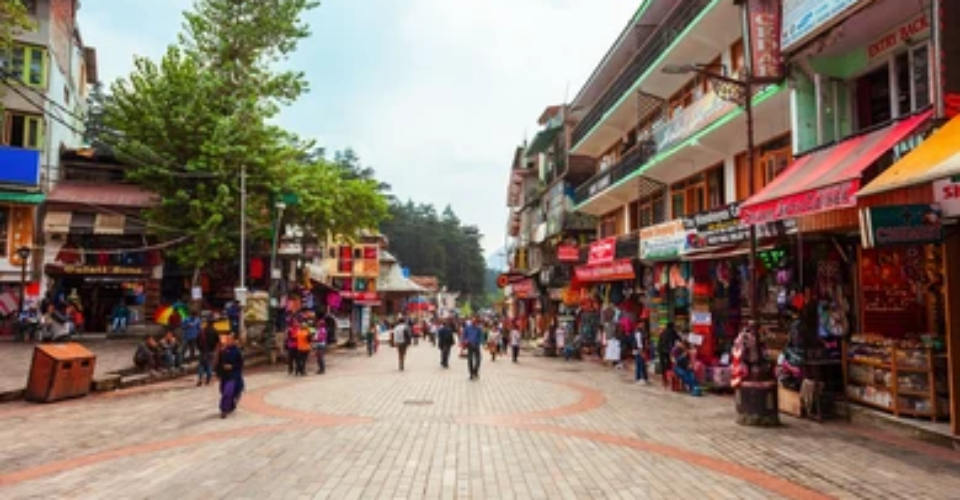
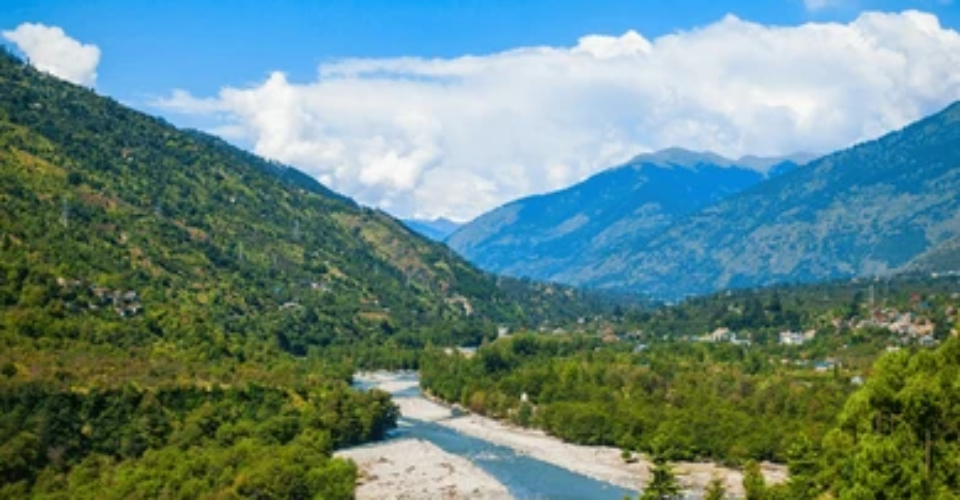
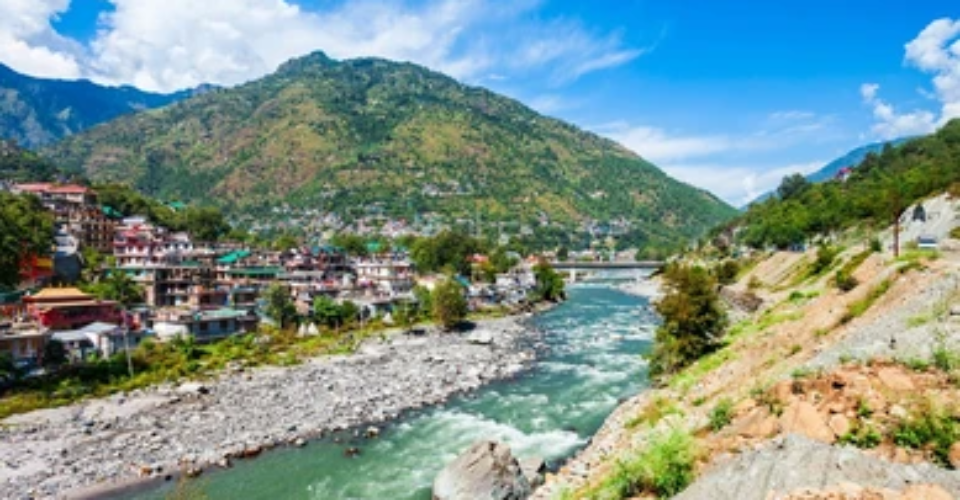
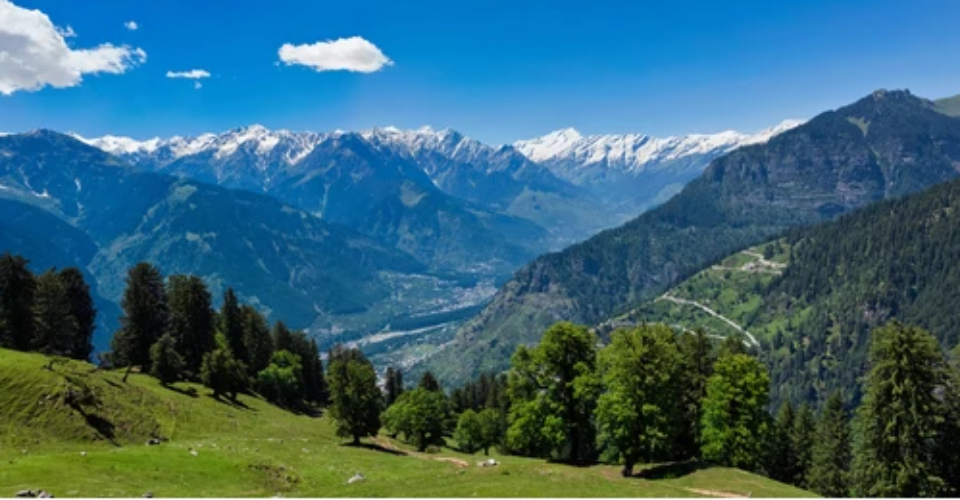
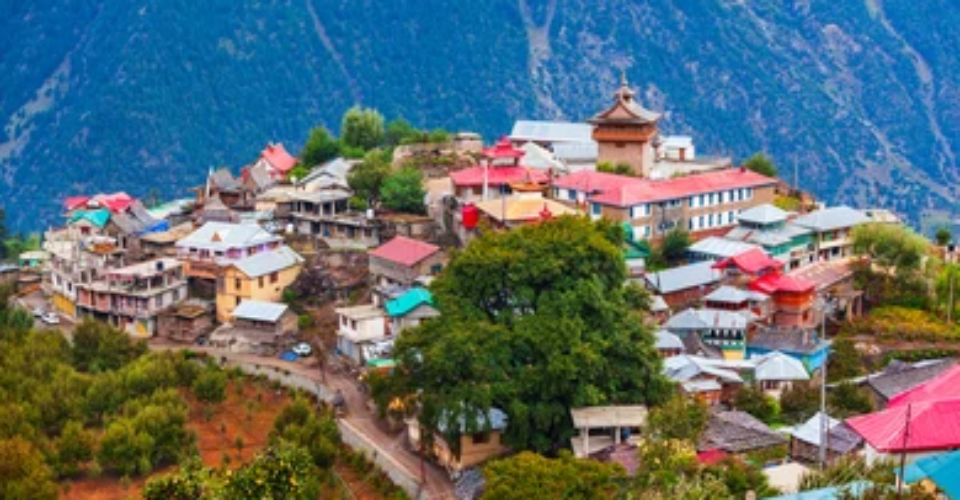
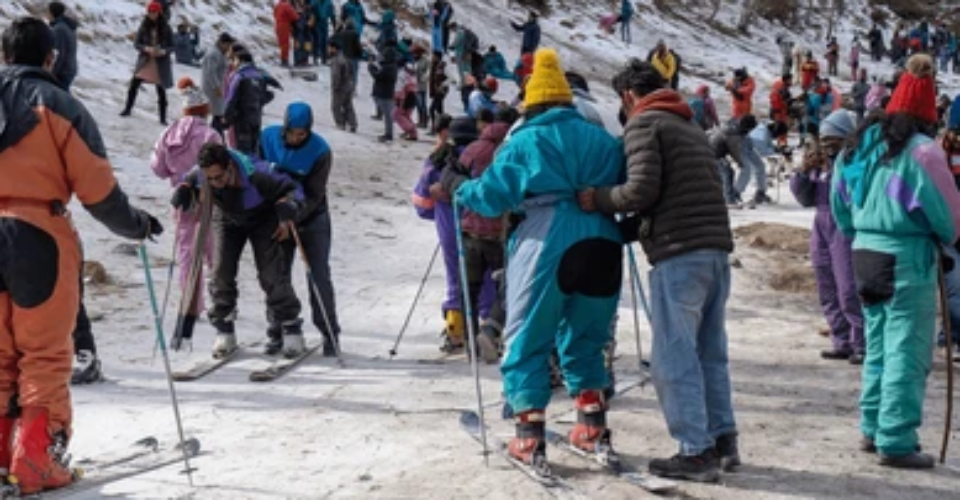
Manali is a beautiful hill station located in the Kullu Valley of Himachal Pradesh, India. It is situated at an altitude of about 2,050 meters (6,726 feet) above sea level and is known for its picturesque landscapes, adventure activities, and pleasant weather. Manali is a popular destination for both nature lovers and adventure enthusiasts, attracting visitors year-round.
The town is surrounded by majestic snow-capped mountains, dense pine forests, and the Beas River, which adds to its scenic charm. The region enjoys a temperate climate, with cool summers and chilly winters. It is especially famous for its snowfall during the winter months, making it an ideal destination for snow sports.
Manali offers a variety of attractions, including the Solang Valley, Rohtang Pass, Hidimba Temple, and the Old Manali area, known for its bohemian vibe and cafes. The town also serves as a base for various trekking routes, including the famous trek to Leh, and is an entry point for exploring the Spiti Valley.
In addition to its natural beauty, Manali is rich in culture, with several temples and monasteries, reflecting the region’s spiritual heritage. Whether you’re looking for adventure, tranquility, or a cultural experience, Manali has something to offer for every traveler.
Manali, a picturesque hill station in the Indian state of Himachal Pradesh, is situated at an altitude of 2,050 meters (6,726 feet) in the Kullu Valley. Its rich cultural heritage, stunning natural beauty, and significance in Hindu mythology have made it one of the most popular tourist destinations in India. The history of Manali is as interesting as the landscape itself, with its roots going back to ancient times.
The history of Manali is intertwined with Hindu mythology. According to ancient texts, the town is named after the sage Manu, the creator of human race, who is believed to have meditated here. In Hindu mythology, it is said that Manu came to this region after the great flood (similar to the story of Noah’s Ark in the Bible) and established the first human civilization in the valley. The “Manu” in Manali is derived from the sage’s name.
Manali was once part of the ancient Kullu Kingdom, a region steeped in mythological significance. The Kullu Kingdom, also known as the “Valley of Gods,” was ruled by local Rajput kings, and the area became known for its strong cultural and religious ties to Hinduism.
During the medieval period, Manali and its surrounding regions were ruled by various Rajput kings and rulers from the Chamba, Mandi, and Kullu kingdoms. The area was relatively isolated, and its natural resources, such as timber, herbs, and other goods, were traded to nearby regions. The town gradually started gaining attention for its strategic location and its proximity to trade routes connecting northern India to Tibet.
The area also witnessed influence from Buddhist monasteries, with several Buddhist structures dotting the landscape of the Kullu Valley. Buddhist culture has deeply impacted the region, and many travelers visiting Manali today can still witness remnants of this influence, such as Tibetan monasteries and prayer flags.
During the British colonial period in the 19th century, Manali started gaining attention as a hill station. The British were drawn to the cool climate and the scenic beauty of the area. Though it wasn’t developed as much as Shimla or Darjeeling, Manali gradually attracted British officers and other expatriates who sought refuge from the scorching summer heat of the plains.
The British government made efforts to improve infrastructure, such as roads and transportation, to make the area more accessible for travelers. During this time, Manali’s potential as a tourist destination began to emerge, though it was still relatively unknown compared to other hill stations in India.
After India gained independence in 1947, Manali continued to develop as a popular tourist destination. The growth of tourism, infrastructure development, and the expansion of road networks made the town increasingly accessible to domestic and international travelers. The construction of the Rohtang Pass road also played a major role in making the region more connected.
In the 1970s and 1980s, Manali became famous for its trekking trails, scenic landscapes, and adventure sports opportunities. The development of hotels, resorts, and other tourist facilities further boosted Manali’s economy.
Today, Manali is one of the most sought-after tourist destinations in India. It is especially famous for its adventure tourism, including skiing, paragliding, rafting, and trekking. The town has seen rapid growth in terms of infrastructure, with a boom in the hospitality industry, modern amenities, and transportation. Manali also has a reputation as a spiritual hub, with many visitors coming for yoga and meditation retreats.
Manali is not just a tourist destination but also holds significant cultural and religious importance. It is home to several ancient temples, such as the Hadimba Temple, which is dedicated to Hadimba, the wife of Bhima from the Mahabharata. The Vashisht Temple and the Manu Temple, dedicated to Sage Manu, are also prominent landmarks in the town. These temples are visited by thousands of devotees every year.
The region is known for its unique blend of Hindu and Tibetan cultures, and the presence of Tibetan monasteries further enhances the spiritual aura of Manali. The town’s proximity to the Tibetan border has also influenced its cuisine, culture, and art forms.
Manali, located in the Kullu district of Himachal Pradesh, India, is a famous hill station nestled in the mighty Himalayas. Owing to its elevation of around 2,050 meters (6,726 feet) above sea level, Manali enjoys a cool, temperate climate throughout most of the year. Its weather and natural beauty make it a popular destination for tourists seeking adventure, relaxation, and a break from the heat of the plains.
Manali experiences a subtropical highland climate (Köppen classification Cwb), characterized by cold winters, pleasant summers, and heavy rainfall during the monsoon season. The town’s climate varies significantly with the seasons, offering a diverse experience depending on when you visit.
Manali, a picturesque hill station nestled in the Indian state of Himachal Pradesh, is a popular destination for nature lovers, adventure seekers, and honeymooners. Located in the Kullu Valley and surrounded by snow-capped peaks and lush greenery, Manali is well-connected by road, and partially accessible by air and rail. Here’s a comprehensive guide on how to reach Manali:
Alternative Airports:
Note: Since Manali doesn’t have a direct railway station, travelers usually prefer reaching Chandigarh or Ambala and then traveling by road.
Manali is very well-connected by an extensive road network.
Note: Overnight buses from Delhi to Manali are very popular.
Shared cabs are economical but slightly less comfortable for long distances
Manali, one of the most popular hill stations in Himachal Pradesh, offers a wide range of facilities to make your visit comfortable, convenient, and enjoyable. Known for its stunning landscapes, adventure activities, and vibrant culture, the town provides modern amenities while preserving its natural beauty.
Manali caters to all types of travelers, from budget backpackers to luxury seekers. You can find a wide variety of accommodations that include hotels, guesthouses, resorts, hostels, and homestays. Here are the options:
Luxury Hotels & Resorts:
Hotels such as The Himalayan, Manu Allaya, and Span Resort offer lavish rooms, top-notch services, and beautiful mountain views.
Resorts like Club Mahindra and The Orchard Greens provide a premium experience with additional amenities like spas, swimming pools, and adventure facilities.
Mid-Range Hotels:
The Manali Inn, Hotel Royal Park, and The Johnson’s Lodge offer comfortable stays with decent amenities such as hot water, Wi-Fi, and in-house dining.
Budget Accommodation & Hostels:
For budget travelers, options like Zostel, The Lost Tribe Hostel, and several guesthouses offer affordable yet cozy rooms, often with shared facilities.
Homestays:
Many locals offer homestays that allow visitors to experience the authentic culture and warmth of Manali’s residents. These often come with home-cooked meals and personalized services.
Manali has a wide array of food options that cater to different tastes and budgets:
Local Cuisine:
Explore traditional Himachali food such as Dham, Siddu, and Chana Madra at local restaurants. Places like Riviera Restaurant and Chopsticks offer a variety of local and North Indian dishes.
International Cuisine:
Manali has a growing number of cafes and restaurants that serve continental, Italian, and Israeli food. Café 1947, The Lazy Dog, and Café Manali are popular among tourists for their cozy ambiance and diverse menu.
Vegetarian & Vegan Options:
There are plenty of vegetarian-friendly eateries, including the well-known The Johnson’s Café and The Café Amigos. Several cafes also offer vegan options.
Street Food:
You can enjoy street food like momoz, chana chaat, and samosas at various stalls, especially near the Mall Road and Old Manali.
Manali offers a variety of shopping experiences, from local handicrafts to international brands.
Mall Road: The main shopping street in Manali, filled with shops selling woolen clothes, shawls, handicrafts, souvenirs, and local spices.
Tibetan Market: Located near the Mall Road, you’ll find Tibetan handicrafts, carpets, and jewelry. The Kullu shawls and pashmina scarves are highly sought-after.
Old Manali: For a more rustic experience, Old Manali has shops selling hand-made jewelry, antiques, and organic products.
Manali has a number of medical facilities to ensure your health and safety during your stay.
Hospitals:
Dr. Ramesh Hospital and Manali Medical Centre are equipped with modern medical facilities and doctors available 24/7.
Primary Health Centre (PHC) in Manali is available for minor medical concerns.
Pharmacies:
Pharmacies are readily available in Manali for all your basic medicines, first aid kits, and over-the-counter drugs.
Ambulance Services:
Ambulance services are available in case of emergencies. Most hotels can arrange for assistance if needed.
Manali is fairly well connected for communication and internet access.
Mobile Network:
All major Indian mobile operators like Airtel, BSNL, Jio, and Vodafone have coverage in Manali. However, some remote areas may have limited connectivity.
Internet/Wi-Fi:
Most hotels, cafes, and guesthouses offer free Wi-Fi, although the speed may vary. There are also cyber cafes for public internet access.
Public Phones:
Public payphones are available in some parts of Manali, though mobile phones have largely replaced this service.
Manali is well-connected by road, and local transport facilities make it easy to explore the town.
Private Taxis and Car Rentals:
Taxi services are abundant in Manali, and private car rentals are available for sightseeing trips. Taxis can also be hired for trips to Rohtang Pass, Solang Valley, and nearby attractions.
Local Buses:
Himachal Road Transport Corporation (HRTC) runs buses that connect Manali with major cities like Delhi, Shimla, Chandigarh, and Kullu. Within the town, buses are available for local transportation.
Auto Rickshaws:
Auto-rickshaws are available for short distances within the town. However, fares should be negotiated beforehand.
Bicycles and Scooters:
Rental shops in Manali offer bicycles, motorcycles, and scooters for rent, making it easier to explore the surroundings on your own.
Manali is renowned for its adventure sports and outdoor activities, offering an array of facilities:
Skiing and Snow Sports: In Solang Valley and Rohtang Pass, you can rent skiing gear and snowboarding equipment, with instructors available for beginners.
Trekking and Camping: Manali offers several trekking trails, such as Hampta Pass, Beas Kund, and Great Himalayan National Park, with camping sites and guides available.
Paragliding: Solang Valley is a popular spot for paragliding, with operators offering tandem flights.
River Rafting: The Beas River offers opportunities for rafting, with professional guides ensuring safety.
Mountain Biking: Rental shops provide mountain bikes, and trails are available for both beginners and experienced cyclists.
ATMs: Manali has several ATMs of major banks such as State Bank of India (SBI), Punjab National Bank (PNB), HDFC, and Axis Bank scattered across the town.
Currency Exchange: While there are no international currency exchange centers in Manali, you can exchange currency at major banks or at the airport before arrival.
Police Station: Manali has a police station located on the Mall Road, where tourists can file reports or seek help in case of emergencies.
Post Office: There is a post office in Manali for sending postcards, parcels, and other postal services.
Tourist Information Centers: The Himachal Pradesh Tourism Development Corporation (HPTDC) has offices in Manali to provide information, maps, and arrange tours for visitors.
Fire Station: Manali has a fire station that is operational 24/7 for fire-related emergencies.
Emergency Numbers:
Police: 100
Ambulance: 108
Fire: 101
Manali, nestled in the picturesque Beas River Valley of Himachal Pradesh, is a paradise for nature lovers, adventure enthusiasts, and culture seekers. Surrounded by snow-capped mountains, lush green valleys, and charming villages, Manali offers a perfect blend of beauty, serenity, and adventure. Here are 10 must-visit attractions in and around Manali that promise an unforgettable experience:
Distance from Manali: 13 km
Known for its stunning scenery and thrilling adventure sports, Solang Valley is a year-round destination. In winter, the valley becomes a hub for skiing and snowboarding, while summer brings opportunities for paragliding, zorbing, and horse riding. The panoramic views of glaciers and snow-capped peaks are simply breathtaking.
Highlights: Skiing, Paragliding, Ropeway rides, ATV rides.
Distance from Manali: 51 km
One of the highest passes in the Himalayas, Rohtang Pass connects Manali to Lahaul and Spiti Valleys. At an altitude of 3,978 meters, it offers awe-inspiring views of glaciers, peaks, and valleys. The pass is accessible from May to November and is famous for its snow adventure activities.
Highlights: Snow activities, Mountain vistas, Scenic drives.
Location: Old Manali
Built in 1553, this ancient wooden temple is dedicated to Hidimba Devi, a figure from the Mahabharata. Surrounded by cedar forests, the temple’s unique architecture, featuring carved wooden doors and a pagoda-shaped roof, makes it a must-visit for history buffs and spiritual seekers.
Highlights: Ancient architecture, Forest surroundings, Spiritual experience.
Location: Old Manali
Dedicated to Sage Manu, the creator of the human race according to Hindu mythology, the Manu Temple is a peaceful spiritual spot. Set amidst narrow lanes and old-world charm, the temple’s location offers stunning views of the valley.
Highlights: Mythological significance, River views, Peaceful atmosphere.
Distance from Manali: 3 km
Located in the quaint village of Vashisht, these natural hot water springs are known for their medicinal properties. Visitors can take a dip in the warm waters or explore the intricately carved stone temples dedicated to Sage Vashisht.
Highlights: Natural hot springs, Healing baths, Ancient temples.
Location: 2 km from Manali town
Old Manali charms visitors with its rustic vibe, traditional Himachali houses, apple orchards, and lively cafes. It’s a great place to relax, enjoy live music, shop for souvenirs, and experience the slower pace of mountain life.
Highlights: Bohemian cafes, Handmade souvenirs, Traditional houses.
Distance from Manali: 4 km trek from Vashisht
This beautiful waterfall is accessible via a scenic trek through pine forests and orchards. Jogini Falls is an ideal picnic spot and offers a serene escape with stunning views of the surrounding mountains and valleys.
Highlights: Scenic trek, Waterfall picnic, Photography.
Distance from Manali: 22 km
Once the residence of the kings of Kullu, Naggar Castle is a historical building made of stone and wood, now converted into a heritage hotel. The castle offers sweeping views of the Kullu Valley and houses a small art museum featuring the works of Russian painter Nicholas Roerich.
Highlights: Ancient castle, Art museum, Valley views.
Distance from Manali: 18 km + 3-4 hours trek
Situated at an elevation of around 4,300 meters, Bhrigu Lake is a sacred high-altitude lake associated with the sage Bhrigu. The trek to the lake passes through lush meadows, alpine forests, and offers mesmerizing views of snow-covered mountains.
Highlights: Trekking, Sacred lake, Panoramic vistas.
Distance from Manali: 25 km to South Portal
The world’s longest highway tunnel above 10,000 feet, the Atal Tunnel connects Manali to the remote Lahaul-Spiti Valley. Driving through this engineering marvel is an experience in itself, with dramatic landscapes unfolding as you exit the tunnel.
Highlights: Engineering feat, Gateway to Lahaul, Scenic drive.
Manali, nestled in the heart of Himachal Pradesh, is a dream destination for nature lovers, adventure enthusiasts, and peace seekers alike. Surrounded by snow-capped mountains, lush valleys, and ancient temples, this hill station offers a perfect blend of tranquility and thrill. Here’s a complete list of things you can do in Manali to make your trip unforgettable:
1. Visit Hadimba Temple
